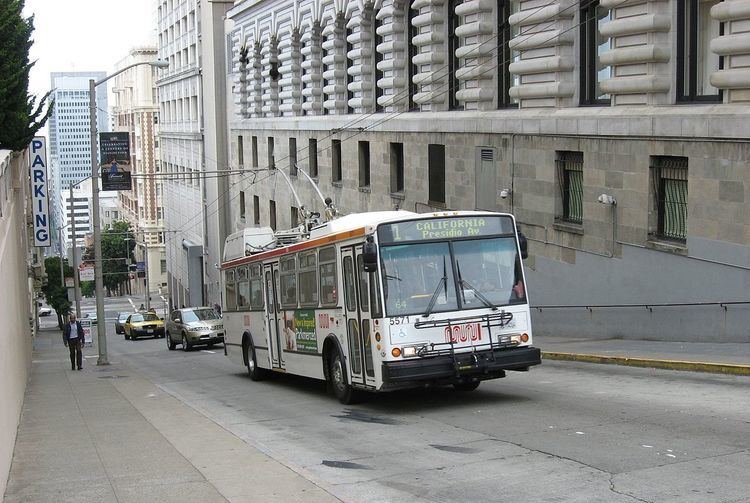Open 1935 (1935) Electrification 600 V DC | Status Open Stock approx. 300 | |
 | ||
Locale San Francisco, California, United States Operator(s) Market Street Railway
(1935–1944)
San Francisco Municipal Railway
(1941–present) | ||
The San Francisco trolleybus system forms part of the public transportation network serving San Francisco, in the state of California, United States. Opened on October 6, 1935, it presently comprises 15 lines, and is operated by the San Francisco Municipal Railway, commonly known as Muni (or the Muni), with around 300 trolleybuses. In San Francisco, these vehicles are also known as "trolley coaches" (a term that was the most common name for the mode in the United States in the middle decades of the 20th Century).
Contents
One of only five such systems currently operating in the U.S., the Muni trolley bus system is the second-largest such system in the Western Hemisphere, after that of Mexico City. A particularly notable feature of its operations are very steep grades. The system includes the single steepest known grade on any existing trolley bus line in the world, specifically 22.8% in the block of Noe Street between Cesar Chavez Street and 26th Street on route 24-Divisadero, and several other sections of Muni trolley bus routes are among the world's steepest.
The Muni trolley bus system is complementary to the city's rail-bound Caltrain, Bay Area Rapid Transit, Muni Metro and cable car system. In addition, it shares some of its overhead wires with the F Market & Wharves streetcar line.
Lines
Trolley buses currently operate the following Muni routes:
Fleet (2010–present)
As of January 2010, the exclusively high-floor Muni trolley bus fleet included 313 serviceable vehicles, comprising three different types, of which 240 were conventional length (two-axle) buses and 73 articulated buses. Of the latter, 40 were New Flyer E60 vehicles (built in 1993–94); 12 of these were retired in early 2013, and the remaining 28 were retired in early January 2015. All of the then-remaining 273 trolleybuses were built by Electric Transit, Inc. (ETI), mostly in 2001–03, the 240 40-foot units being model 14TrSF and the 33 articulated units being model 15TrSF.
An order was placed in 2014 for 60 New Flyer XT60 articulated vehicles, the system's first low-floor trolleybuses. Two prototypes (Nos. 7201 and 7202) arrived in March 2015 and May 2015, respectively, and entered service in May and September 2015. Delivery of the 58 production-series vehicles began in September 2015, and the series entered service between November 2015 and July 2016. They replaced the 33 ETI 15TrSF articulated trolleybuses, the last of which were retired in April–May 2016. These changes left the current fleet with the 240 conventional units built by ETI (model 14TrSF) and 60 New Flyer XT60s. The articulated trolleybuses are used on the 5R, 14 and 30S lines.
The suffix SF in the two ETI model numbers stands for San Francisco. These two types were specially derived from the standard series Škoda 14Tr for use on the Muni system. The model XT60 for New Flyer has prefixes X for Xcelsior and T for electric (trolleybus), and the suffix 60 for the 60-foot bus.
Future fleet
In 2013, the SFMTA adopted plans for an eventual one-for-one replacement of the existing trolleybus fleet in a joint agreement with King County Metro and New Flyer over technical specifications and pricing. The first order to be placed under the 2013 agreement was the 2014 order for 60 articulated trolleybuses, delivery of which began in 2015.
